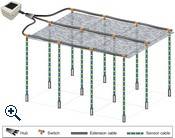Leakage Detection in Construction Sites
The sealing of construction sites extending below the water table (particularly the joints between bottom and walls) has to be checked before starting to excavate, because ground water intruding into the emptied pit may cause severe damages and delay construction works.
A usual method to detect such leakages is pumping down the water level while monitoring the temperature distribution inside the pit. If leakages are present, ground water from outside (differing in temperature) will penetrate into the pit. This causes growing anomalies in the temperature distribution, indicating positions and approximate sizes of the leaks.
Layout of Measuring Network
A sufficient number of narrow boreholes for the sensor cables is placed inside the excavation pit. The cables are linked using switches and extensions, the whole measuring network is connected to a central TkMonitor unit.
Data Processing and Results
A suitable three-dimensional representation of the temperature changes relative to the beginning of measurements serves to analyze the development of the temperature field inside the excavation pit. The example (click to enlarge) shows two leakages where cold water is entering (a larger one at the bottom left and a smaller one at the right side).
To be able to follow the development of the anomalies closely enough, and to clearly distinguish ground water intruding through a leakage from other disturbances, intervals between measuring cycles should be as short as possible (the example includes just a small selection of time steps). Hence the short TkMonitor cycle intervals of a few minutes constitute a crucial advantage compared to other measuring systems, enabling a quasi-continuous temperature monitoring.

